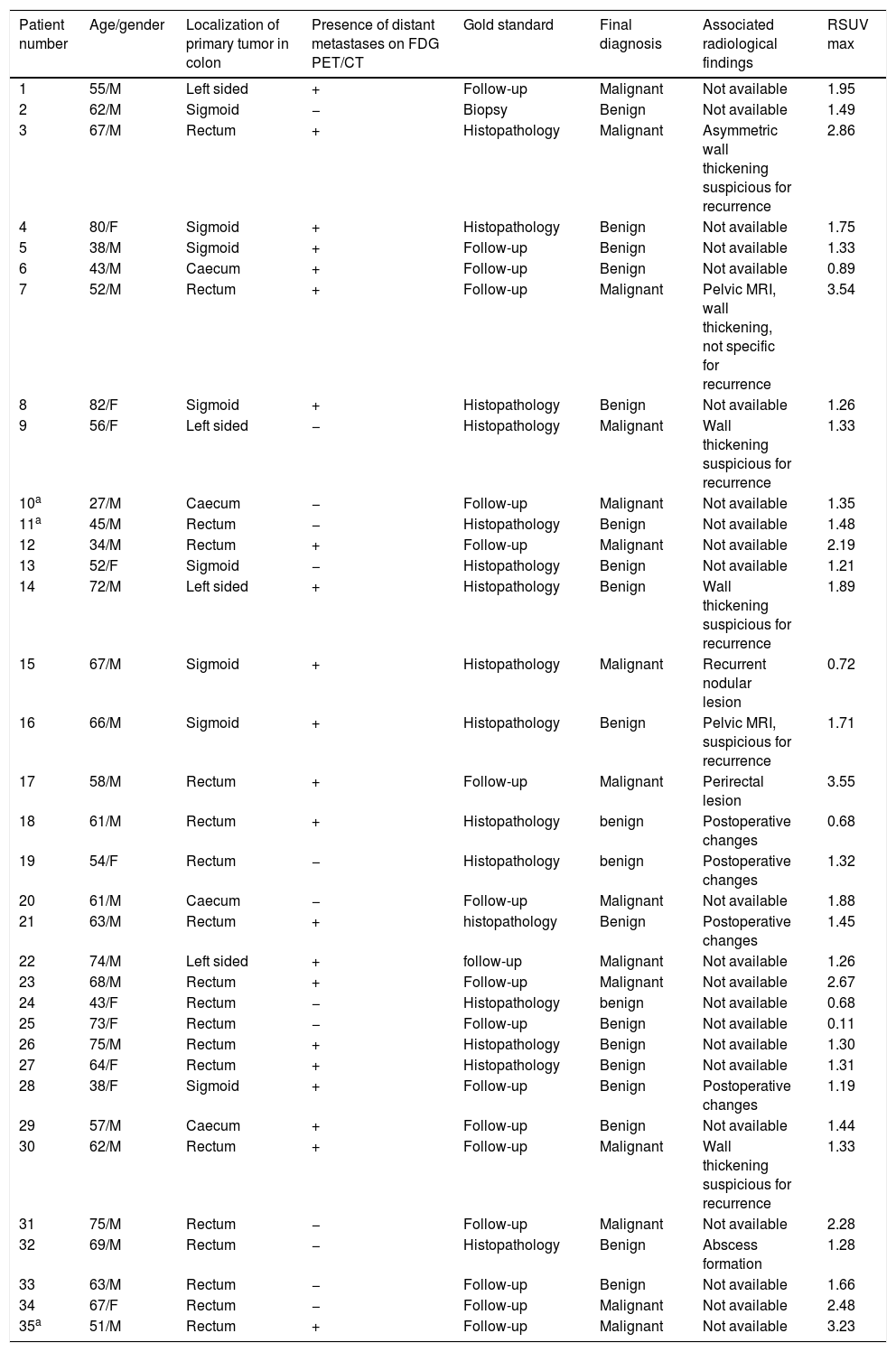Recurrence of colorectal cancer is mostly seen within the first 2 years after surgery. The most frequent site of recurrence is the postsurgical areas and its surroundings. The purpose of this study was to evaluate the usefulness of semiquantitative analysis of 18Fluorine fluorodeoxyglucose (FDG) positron emission tomography/computed tomography (PET/CT) in determining recurrence of colorectal carcinoma in the operation site.
Materials and methodsFiles of 35 patients with colorectal carcinoma (25 men, 10 women, mean age: 59.25±2.82 years, range: 27–80 years) who were treated with surgery and underwent FDG PET/CT scanning for restaging of colorectal carcinoma and showing increased FDG uptake in the postsurgical area, were retrospectively analysed. Besides calculating SUVmax of the areas showing FDG uptake, SUVmax of physiological colonic activity was also obtained and SUVmax of lesion/SUVmax of colonic wall (RSUVmax), was calculated. Characteristics of FDG uptake were classified according to histological analysis or clinical and imaging follow-up.
ResultsIn 17 of 35 patients (49%) the standard of reference for the final diagnosis was histologic analysis and in 18 (51%), final diagnosis was based on imaging and clinical follow-up. In 15 of 35 patients (43%) the etiology of increased FDG uptake was recurrence and in 20 (57%), FDG accumulation was observed due to benign etiology. The difference between the mean of the results of SUVmax in patients with recurrent disease and with no evidence of recurrence was statistically significant (p=0.030). For SUVmax, a cut-off value for recurrence was calculated as 9.51 with a sensitivity of 80% and a specificity of 70%. In terms of RSUVmax results, a statistically significant difference was also observed between mean values in patients with recurrent disease and in those without (p=0.002). ROC analysis demonstrated that the best predictive value of RSUVmax for recurrence was 1.75 with a sensitivity of 67% and specificity of 95%.
ConclusionsSemiquantitative analysis of FDG PET/CT may be used in detecting recurrent disease of patients with colorectal carcinoma. Eliminating interfering physiological colonic activity in analysis may have an incremental effect on the success of this technique, by means of increasing the specificity.
La recurrencia del cáncer colorrectal aparece principalmente en los primeros 2 años después de la cirugía. El sitio de recidiva más frecuente es la región posquirúrgica y su entorno. El propósito de este estudio fue evaluar la utilidad del análisis semicuantitativo de la captación de 18F-fluorodeoxiglucosa (FDG) con tomografía por emisión de positrones/tomografía computarizada (PET/CT) para determinar la recurrencia del carcinoma colorrectal en el lugar de la intervención quirúrgica.
Material y métodosSe analizaron de forma retrospectiva 35 pacientes con carcinoma colorrectal (25 hombres, 10 mujeres, edad media: 59.25±2.82 años, rango: 27-80 años) tratados con cirugía a los que se les realizó una PET/CT con FDG para reestadificación y que mostraron un aumento de la captación de FDG en la anastomosis. Además del cálculo de SUVmax de las áreas que presentaron captación de FDG en el sitio de la intervención quirúrgica, también se obtuvo el SUVmax de la actividad fisiológica del colon y se calculó el SUVmax de lesión/SUVmax de la pared del colon (RSUVmax). Las características de la captación de FDG se clasificaron de acuerdo con el análisis histológico o el seguimiento clínico y de estudios de imagen.
ResultadosEn 17 de 35 pacientes (49%) el estándar de referencia para el diagnóstico final fue el análisis histológico y en 18 (51%), el diagnóstico final se basó en imágenes y seguimiento clínico. En 15 de 35 pacientes (43%) la etiología del aumento de la captación de FDG fue la recurrencia y en 20 (57%), la acumulación de FDG se observó debido a la etiología benigna. La diferencia entre la media de los resultados de SUVmax en pacientes con enfermedad recurrente y sin evidencia de recurrencia fue estadísticamente significativa (p=0.030). Para SUVmax, se calculó un valor de corte de 9.51 con una sensibilidad del 80% y una especificidad del 70%. En términos de resultados RSUVmax, también se observó una diferencia estadísticamente significativa entre los valores medios en pacientes con enfermedad recurrente y en los que no (p=0.002). El análisis ROC demostró que el mejor valor predictivo de RSUVmax era 1,75 con una sensibilidad del 67% y una especificidad del 95%.
ConclusionesEl análisis semicuantitativo de FDG PET/CT se puede usar para detectar enfermedad recurrente en pacientes con carcinoma colorrectal. La eliminación de la interferencia de la actividad fisiológica del colon en el análisis puede tener un efecto incremental sobre el éxito de esta técnica mediante el aumento de la especificidad.
Article
If you experience access problems, you can contact the SEMNIM Technical Secretariat by email at secretaria.tecnica@semnim.es or by phone at +34 619 594 780.

Revista Española de Medicina Nuclear e Imagen Molecular (English Edition)











